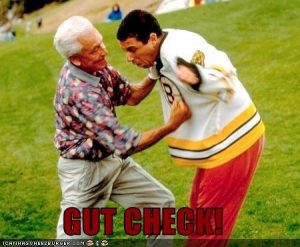

By: Jeremy Shackett, Engagement Manager at Bang the Table
Since 2007, local governments have come to us with community engagement horror stories from the past. We have shared a laugh or lesson learned with them. Sometimes we notice that these bad experiences have led to misconceptions around what it means to meaningfully engage the community, and why engagement is important. To start this important dialogue, here is a sample of the misconceptions we hear.
Community engagement is too risky.
Community engagement is seen as risky by some because they only know the experience of running a town hall meeting that has the same ten people yelling at them. If these ten people cause trouble already, then what about one thousand of them?
As it turns out, the business as usual approach actually carries much more organizational risk than a robust community engagement strategy.
There will always be those same ten professional meeting attendees. Traditionally they are often the only ones up at the mic – which benefits their cause. As the saying goes, “the squeaky wheel gets the grease.” If you are a local leader who only hears the same ten people over and over, this risks them occupying valuable real estate in your mind.
Sometimes, there is a project that encounters mobilized opposition from more than the same ten people. Meaningful community engagement can help you be proactive, rather than reactive, when an issue like this arises. Asking people their thoughts early will help you frame the conversation in ways that will be conducive to your process and ultimately for decision making. It will create an environment of shared values rather than positions that can quickly become polarized. You might also find compromises or tweaks to make opponents of the project more likely to accept it. If you don’t engage on a controversial project at all, however, you risk the entire thing being shelved due to the opposition.
Gut check: What is my organization risking by NOT engaging the community?
All I need to do is a survey or poll.
When you need to collect feedback from the public, your traditional go-to online tool is a survey. As I wrote before in my ELGL article, Think Beyond the Survey, surveys are an easy decision for an organization to make when formulating an engagement strategy. Nobody needs to explain to their boss what a survey is or convince them to adopt this weird radical new survey idea – especially when there are beginner tools out there to use.
As it turns out, however, surveys are limiting because they are specifically designed to be inflexible. The hiding of participants’ identities is great when you need anonymized data but removes the ability to start a group conversation or ask follow-up questions. By asking the same people the same questions, you can receive more structured feedback–but at the expense of limiting the conversation to the boundaries you set.
If the community wants to have a meaningful discussion about an important topic but is given a survey, it risks being perceived as disrespectful and that their input does not matter.
Use surveys at the end of a project to validate that the engagement work you did at the front-end of the project really reflects the community’s desires. During the beginning of the process, however, use other approaches such as ideation, two-way discussion, and Q&A to show your community that you’re listening.
Gut check: When was the last time a survey made me feel like I mattered?
My community is too small.
There are ways to turn the small size of your community into an advantage. First of all, because your town is likely to be smaller in size geographically, you will not need to go to as many places to reach a meaningful sample of your community. Distribute signs and flyers in the downtown square, or other common gathering places–coffee shops, library, recreation facilities. Build on the connections that exist already–churches, civic clubs, groups that come together and ask to introduce your engagement site to them at their already established meeting dates and location.
Smaller communities are more likely to have stronger social ties between neighbors than large cities. This leads to a happier, more engaged public – and also a better chance for you to spread the word about your community engagement initiatives through word of mouth.
Gut check: How is my town’s small size actually an asset?
People in my community just don’t care.
Because your residents’ decision about where to live is one of the biggest ones they will make, they do care about your city’s future and the decisions that your local leaders make. If they have a chance to collaborate and contribute to decision-making, they will gladly join you – as long as you set reasonable parameters around how they can help.
Your residents care, but that does not automatically mean they will answer every discussion topic you put in front of them. They are likely too polite to tell you this while enjoying the free food you provided at your public meeting, but they can sense when you are just trying to check the box.
Therefore, no, most people will not draw your new bus route for you, or write your climate adaptation plan, or answer what to cut from your budget. No matter how much information you provide, they will not engage because they know the question is way over their head. Asking them a question they can’t possibly answer is condescending – both to the residents that took the time out to attend your public meeting and to the staff that was hired specifically to be subject matter experts in these topics.
The Town of Parker asks residents to place pins on a map to report traffic violations, providing the police department with an early warning system for potential issues. The City of Boulder asks residents to share stories about what it means for them to walk in the city, and what bus facilities are hard to walk to. They didn’t give residents any illusions that they would be police chief or transportation director for a day – they asked residents questions that they could answer from their day-to-day life experience. By asking great questions, and doing so in a user-friendly online platform, both organizations were rewarded with rich feedback that could then be incorporated into decision-making.
Gut check: Am I asking residents questions where they’re the expert and can really have a say, or am I just trying to check the box and validate my own conclusions?
I don’t have the staff time.
Meaningful community engagement really is hard, because at the end of the day it is about connecting with people. It’s hard already, so the thought of broadening your reach by 100x elicits fear. That’s 100x more work, right?
As it turns out, you are likely doing a lot of online engagement work already, but it might be inefficient. You might be publishing information about major projects on a hard-to-reach section on your website. Each one of your departments might be using their own survey tool or comment box to collect feedback, pushed out to separate email lists. You might have worked late into the night wrangling raw data and Excel graphs to produce a report of resident feedback.
For most community engagement platforms, the only added time you will spend is learning a new piece of software (which will vary depending on how user-friendly it
is) and phasing out old tools and habits. Ongoing maintenance will take just as much or possibly even less time, depending on how well you relate to the examples in the above paragraph.
One of my favorite examples of a time-saving engagement strategy achieving huge results is the Willoughby method. Named after our client in Australia, the Willoughby method takes this approach:
- Publish one project per month on your engagement website no matter what. If you don’t have a major project, publish something small or fun.
- Send email newsletters to your participant database after each project launches to bring registered users back into the process.
- Promote your community engagement platform across your existing communications channels, including public meetings and your main website, to grow organic traffic.
 We have not noticed any association between available staff time and community engagement success. Everyone is busy doing some form of engagement these days. What separates the most successful organizations from the rest is whether they make their technology and processes work for them, rather than against them.
We have not noticed any association between available staff time and community engagement success. Everyone is busy doing some form of engagement these days. What separates the most successful organizations from the rest is whether they make their technology and processes work for them, rather than against them.
Gut check: When was the last time you could achieve 10x the results with 10% more staff time?
This is just the start of robust dialogue. As more organizations warm up to the importance of meaningful community engagement, I encourage you to check out the ELGL Engagement Corner, where your peers share examples of best practices in the field. You can also join my colleague, Anthea Robinson-Shaw, on a webinar discussing Community Engagement for Small Cities.
 Jeremy Shackett is an Engagement Manager at Bang the Table. Jeremy holds a BA in Urban Planning from the University of Illinois at Urbana-Champaign. Through his development of a mobile community engagement app, Gymnasium, he was a speaker and finalist in the American Planning Association’s Innovating Planning Apps Competition in 2016. He also studied at the Danish Institute for Study Abroad, Denmark, with a concentration in urban design. Jeremy is a Tampa native who previously interned at the Hillsborough County City-County Planning Commission prior to joining Bang the Table.
Jeremy Shackett is an Engagement Manager at Bang the Table. Jeremy holds a BA in Urban Planning from the University of Illinois at Urbana-Champaign. Through his development of a mobile community engagement app, Gymnasium, he was a speaker and finalist in the American Planning Association’s Innovating Planning Apps Competition in 2016. He also studied at the Danish Institute for Study Abroad, Denmark, with a concentration in urban design. Jeremy is a Tampa native who previously interned at the Hillsborough County City-County Planning Commission prior to joining Bang the Table.
